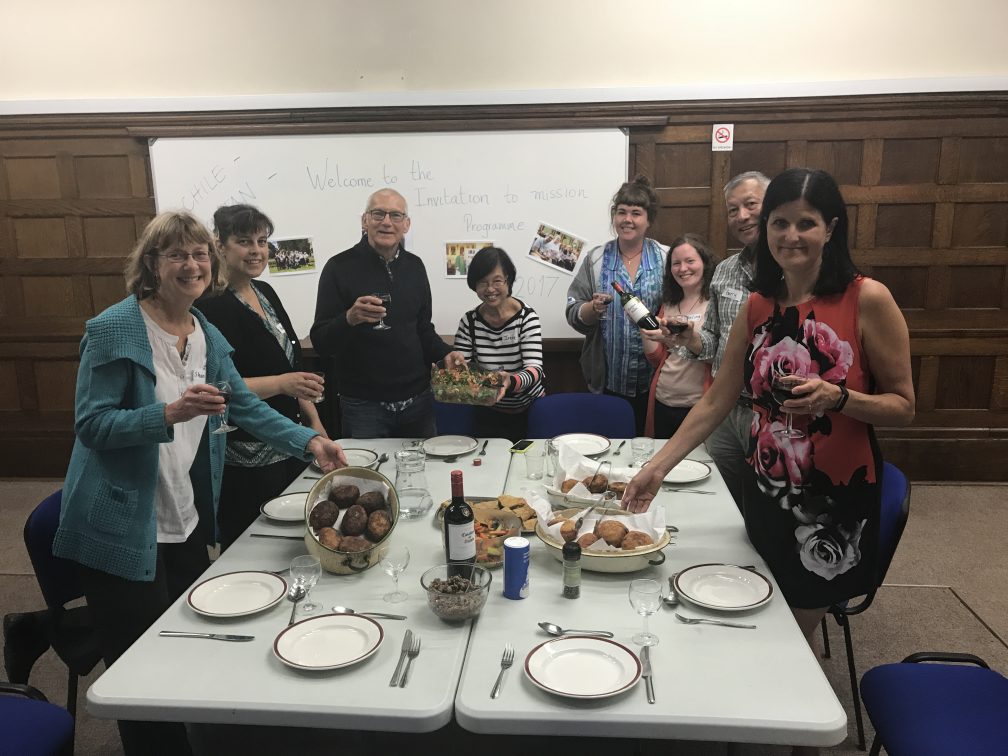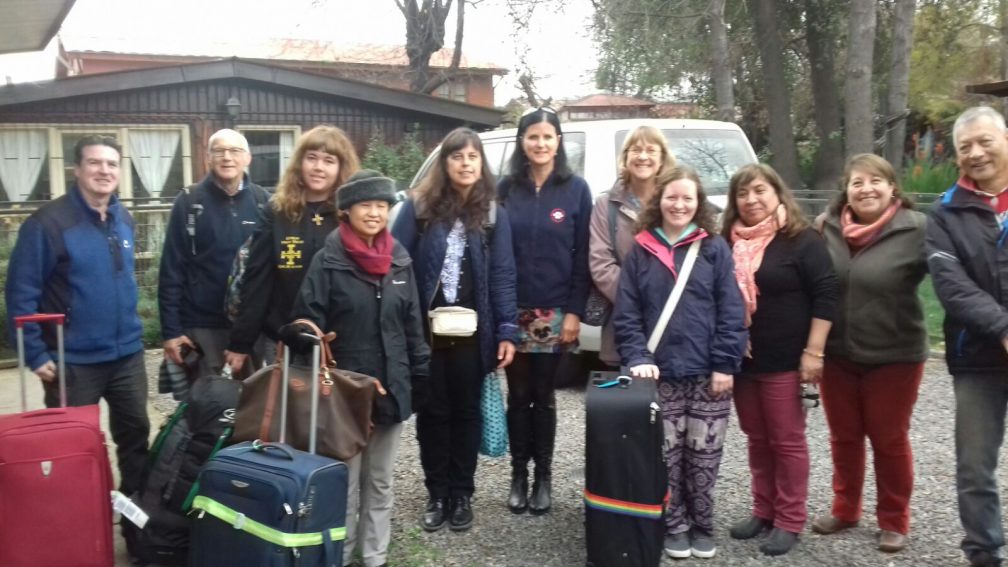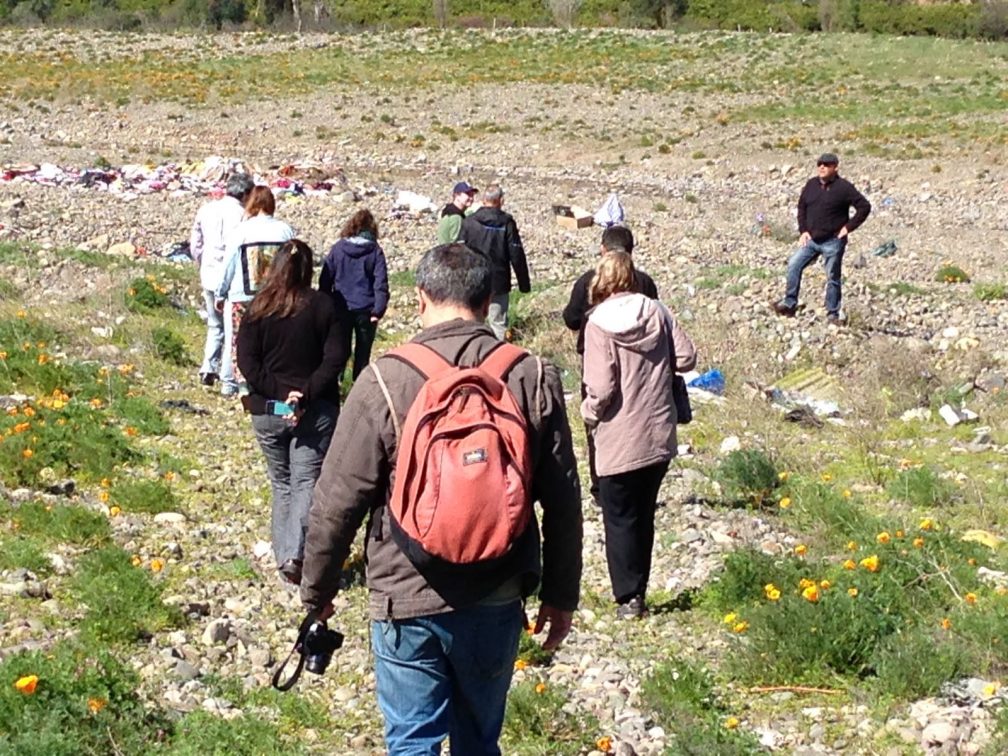Shari Brown
A museum of horror or a park of peace? Such was the question Chileans faced when they came together to discuss how to remember Villa Grimaldi. Today we visited this site of detention and torture during Pinochet’s rule and learnt about the horrors that took place there. Yet the lavender at the entrance, numerous trees and birds singing were testimony to the decision to create a park of peace – a place of memory focusing foremost on the survival and resilience of humanity. The rose garden particularly moved me as wooden ‘roses’ among the real roses bore the names of women who were executed or disappeared. The enscribed words of Gabriela Mistral, a famous Chilean poet, reminded us that: “We were all to be Queens” (or Kings if men) so affirming life rather than death.
From there we went through the wealthy area of Santiago viewing the big homes, cultural tourist hub (lunch of Empanadas was good!) and then the business district of embassies, banks and tall buildings of commerce. The contrast was therefore all the greater when we travelled outwards to the periphery of the city for our evening programme. Plaza de Puente Alto is at the end of the metro line and in 20 years has grown from approximately 100,000 to 600,000 people. The growth has been deliberate government policy as a result of ‘cleansing’ the centre of the city of poorer districts. The people have been forcibly removed to the outskirts where housing and services are inadequate and job opportunities are few.
Irene Prentice
The following morning we met the rest of the Invitation to Mission group at the Chapel of St. Andrew Kim Taegon where we were warmly welcomed with tea and snacks by the Catholic community there. Sr Kath, a Columban sister, gave the keynote presentation, and gave us an insightful account of her 43 years’ experience in Chile, and around the Catholic community of Puente Alto, south of Santiago. As background information, we were informed that the parish was an agricultural community of 13,000 inhabitants in 1985. By 2012, this had increased to approximately 140,000 inhabitants. The Catholic chapel where we gathered was part of the parish of San Pedro de Nolasco, founded in 1887.
Sr Kath explained that the root cause of social problems in Bajos de Mena – where San Pedro de Nolasco is situated – is due to social injustice, discrimination, and unemployment, due to the lack of education. In addition, the inhabitants live in poor housing conditions, lacking in space and cheaply built. This result is abuse of drugs, drug trafficking, and child abuse. A poor diet due to poverty meant that there was an increase in problems associated with obesity whilst not very long ago, malnutrition was prevalent. These are the people that Sr Kath works with. These are the issues that Sr. Kath works with in the community.
One way of connecting with the people in the parish was being visibly present outside, tending to the plants around her house, and keeping the roadside clean. By doing this and being a familiar face around, greeting passer-bys, exchanging pleasantries, she soon became a friend, someone to be trusted with problems, providing a listening ear, and offering comfort and a hug. This is a commitment over a period of time and not a short-term effort. This is also missionary work.
Gerry Young and Aisling Griffin
After a night of heavy rain, we caught the 7am flight from Santiago to the northern city of Iquique, not far from the Peru and Bolivia borders. We were met at the airport by Oisín, a Columban lay missionary, and Patricio and were driven to Alto Hospicio, a poor suburb overlooking the city, to the Columban House. Fr. Miguel and Fr. Tom welcomed us warmly, with a breakfast (more like a lunch), together with Lorna and Gilda, two lay missionaries who, together with Oisín, make up the Columban team here. The Columban House is modest, both on the outside and inside and is on a busy, dusty Street. It was great to meet and share with every one of these warm and interesting Columbans, a society that, by now, I’ve grown to associate with loads of charisma and a wealth of knowledge about the communities they serve.
We could all have chatted for much longer, if not for our programmed visit to the comedor (a free drop-in lunch) for the poor, homeless and needy, organised by Sr Dora and her nuns from the Order of the Immaculate Conception. There were 80 homeless or marginalised families invited from all of the local parishes with an enthusiastic and huge number of volunteer helpers wearing CARITAS t-shirts.
Tables were laid under several marquees in a long line outdoors, on a public street, with a central podium where there was a group of children entertaining the assembling guests to a lively rhythmic drumming show. We mingled with the helpers and, when lunch was cooked, we joined in serving plates of roast chicken, rice and salad, to the now many guests. We blended well with the local volunteers as even some of the guests approached us to chat or to ask directions to the barber, who was another volunteer offering free haircuts. This lunch was a truly great example of Christian action in practice!
We were also taken for two walks, one before lunch by Fr. Miguel around the local area to see the newly built Church of the Sacred Heart and the on-going construction at the rear, and the other walk after lunch, with Oisín, to the run-down shanty town where Oisín runs another comedor (a free drop-in meal for the needy and their children). The area where Oisín Works suffers much crime and it’s many abodes are either self- constructed by their owners under the government scheme to develop the area, or badly assembled huts for the destitute. Another jaw dropping, eye-opener for us!
John Waddoups
On Wednesday we were driven by Helmut to La Ligua river in Comuna Cabildo about 130 kilometers from Santiago. We met Rodrigo Mundaca, an agricultural engineer. He explained how powerful landowners had planted avocado and citrus fruit trees which drained the water with illegal drains from the La Ligua River. This caused the river to dry up and local people and farmers did not have enough water for their needs. Their human rights were being violated by not having access to clean water. The government did provide water from tankers but the local people had to buy it. The environment was also being damaged as there was not enough water to sustain plant life. The river had been dry for 18 years. Local children had not seen running water in the river and it was being used as a rubbish dumping ground.
We also met Veronica, the director of a pumping station which had government permission to be operative. This provided water for about 1000 people. Yet she was being taken to court by the government over this legal water pumping station whilst powerful local farmers were being ignored over illegal drains for their plantations. Local people also blamed Veronica if there was no water even though she was a volunteer who worked nearly every day including major holidays. We also met Claudia who operated and maintained the pumping station.
After this we drove to a local restaurant where we ate and watched a DVD in which famous actors spoke out about water rights of local people. We then drove into the higher Andes to look at free flowing tributaries which did not reach the main river. This was because the powerful farmers piped the water to their plantations. The land was very green and fertile in stark contrast to the dry river valley below. We also met local farmers who had even been shot at for protesting against the illegal draining of water sources. Rodrigo himself has been taken to court and fined over 20 times.




